Emergence
The term Freibataillon emerged in the Holy Roman Empire in the second half of the 17th century for troops formed outside of the regimental system. With the development of linear tactics, light troops were needed for outposts, security and reconnaissance tasks. The soldiers recruited were supposed to be "free" of the normal discipline of the main army.
Pandurs and Croats were used in this way by the Austria in the War of the Austrian Succession. Frederick II was impressed by them and created the Freibatallione, which operated independently and disrupted the enemy with sudden, surprise attacks. They were also used to defend the Pandurs of Maria Theresia. In the Prussian Army, free battalions were often formed from the hussars, jägers and regular infantry and were detachiert, i.e. just detached for the role. A battalion could comprise about 1,000 men, often with a light battery of several guns. In the course of the war, a total of 14 units was established, mostly under the leadership of Huguenot nobles:
- Le Noble (F 1),
- Mayr/Collignon/Courbiere (F 2),
- Kalben/Salenmon (Favrat) (F 3),
- Angelelli/Collignon (F 4),
- Chossignon/Monjou (F 5),
- Rapin/Lüderitz (F 6),
- Wunsch (F 7),
- Du Verger/Quintus Icilius (F 8),
- Hordt (F 9),
- Jeney (Voluntaires d'Ostfrise) (F 10),
- Schack (F 11),
- Heer (Schweizer Volontaires) (F 12),
- Bequignolles (F 13),
- La Badie (Volontaires Etrangers) (F 14).
Particularly well known was the advance of Mayr's Freibataillon (F 2) from Prussian-occupied Electoral Saxony to Franconia in May/June 1757.
With the transfer of the light infantry into line regiments at the end of the 18th century, free battalions disappeared.
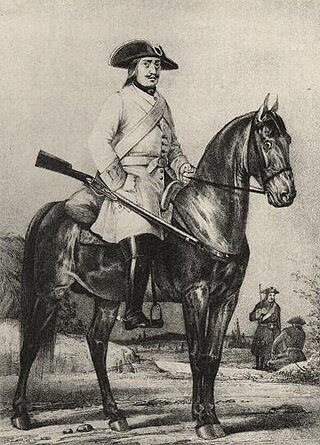
Dragoons were originally a class of mounted infantry, who used horses for mobility, but dismounted to fight on foot. From the early 17th century onward, dragoons were increasingly also employed as conventional cavalry and trained for combat with swords and firearms from horseback. While their use goes back to the late 16th century, dragoon regiments were established in most European armies during the 17th and early 18th centuries; they provided greater mobility than regular infantry but were far less expensive than cavalry.

Freikorps were irregular German and other European paramilitary volunteer units that existed from the 18th to the early 20th centuries. They effectively fought as mercenaries or private military companies, regardless of their own nationality. In German-speaking countries, the first so-called Freikorps were formed in the 18th century from native volunteers, enemy renegades, and deserters. These sometimes exotically equipped units served as infantry and cavalry ; sometimes in just company strength and sometimes in formations of up to several thousand strong. There were also various mixed formations or legions. The Prussian von Kleist Freikorps included infantry, jäger, dragoons and hussars. The French Volontaires de Saxe combined uhlans and dragoons.

A grenadier was historically an assault-specialist soldier who threw hand grenades in siege operation battles. The distinct combat function of the grenadier was established in the mid-17th century, when grenadiers were recruited from among the strongest and largest soldiers. By the 18th century, the grenadier dedicated to throwing hand grenades had become a less necessary specialist, yet in battle, the grenadiers were the physically robust soldiers who led vanguard assaults, such as storming fortifications in the course of siege warfare.

The Battle of Rossbach took place on 5 November 1757 during the Third Silesian War near the village of Rossbach (Roßbach), in the Electorate of Saxony. It is sometimes called the Battle of, or at, Reichardtswerben, after a different nearby town. In this 90-minute battle, Frederick the Great, king of Prussia, defeated an Allied army composed of French forces augmented by a contingent of the Reichsarmee of the Holy Roman Empire. The French and Imperial army included 41,110 men, opposing a considerably smaller Prussian force of 22,000. Despite overwhelming odds, Frederick managed to defeat the Imperials and the French.

Jäger is a German military term referring to specific light infantry units.

The Battle of Leuthen was fought on 5 December 1757 between Frederick the Great's Prussian Army and an Austrian army commanded by Prince Charles of Lorraine and Count Leopold Joseph von Daun. Frederick used maneuver warfare and knowledge of the terrain to rout the larger Austrian force completely. The victory ensured Prussian control of Silesia during the Third Silesian War, which was part of the Seven Years' War.

Chasseur, a French term for "hunter", is the designation given to certain regiments of French and Belgian light infantry or light cavalry to denote troops trained for rapid action.

Baron Franz von der Trenck was an Austrian soldier whose unit is considered one of the worst in modern European history, and which was a law unto itself, taking property, livestock, and women as the unit saw fit.
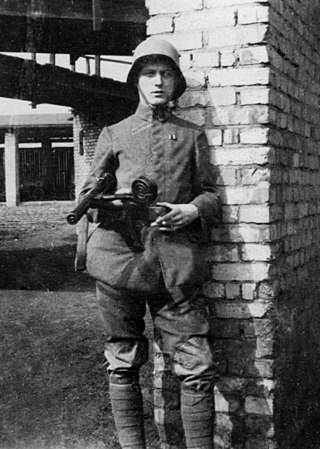
Stormtroopers were the only elite shock troops of the Imperial German Army that specialized in commando style raids, infiltrating the trenches and wiping out the enemy quickly, maneuver warfare, reconnaissance, and shock tactics. In the last years of World War I, Stoßtruppen were trained to use infiltration tactics – part of the Germans' improved method of attack on enemy trench warfare. The German Empire entered the war certain that the conflict would be won in the course of great military campaigns, thus relegating results obtained during individual clashes to the background; consequently the best officers, concentrated in the German General Staff, placed their attention on maneuver warfare and the rational exploitation of railways, rather than concentrating on the conduct of battles. This attitude made a direct contribution to operational victories of Germany in Russia, Romania, Serbia and Italy, but it resulted in failure in the West. Thus the German officers on the Western Front found themselves in need of resolving the static situation caused by trench warfare on the battlefield.

Trenck's Pandurs were a light infantry unit of the Habsburg monarchy that was raised by Baron Franz von der Trenck under a charter issued by Maria Theresa of Austria in 1741. The unit was largely composed of volunteers from the Kingdom of Slavonia and Slavonian Military Frontier, and named after security guards otherwise employed to maintain public order. The Pandurs were presented to the empress in May 1741 with the unit's military band earning them a claim of pioneering martial music in Europe. The Pandurs did not use uniforms and had an overall Ottoman appearance. The original organization of the unit was retained until 1745, when it transformed into a regiment. Trenck was relieved of command in 1746 and imprisoned in Spielberg Castle, where he died in 1749. The unit ultimately transformed into the 53rd Infantry Regiment, headquartered in Zagreb, until it was disbanded in 1919. The regiment's commemorative medals bear Trenck's image wearing Pandur attire.

Line infantry was the type of infantry that formed the bulk of most European land armies from the mid-17th century to the mid-19th century. Maurice of Nassau and Gustavus Adolphus are generally regarded as its pioneers, while Turenne and Montecuccoli are closely associated with the post-1648 development of linear infantry tactics. For both battle and parade drill, it consisted of two to four ranks of foot soldiers drawn up side by side in rigid alignment, and thereby maximizing the effect of their firepower. By extension, the term came to be applied to the regular regiments "of the line" as opposed to light infantry, skirmishers, militia, support personnel, plus some other special categories of infantry not focused on heavy front line combat.

Kriegsspiel is a genre of wargaming developed by the Prussian Army in the 19th century to teach battlefield tactics to officers. The word Kriegsspiel literally means "wargame" in German, but in the context of the English language it refers specifically to the wargames developed by the Prussian army in the 19th century. Kriegsspiel was the first wargaming system to have been adopted by a military organization as a serious tool for training and research.

The Battle of Trautenau or Battle of Trutnov was fought on 27 June 1866, during the Austro-Prussian War. It was the only battle of the war that ended in an Austrian victory over the Prussians, but at a large cost.

The Battle of Gitschin or Jičín took place during the Austro-Prussian War on 29 June 1866, ending with a Prussian victory over the Austrian forces. There is a memorial there today at Jičín in the Czech Republic.

The Battle of Focșani took place during the Russo-Turkish War (1787–1792) on 1 August 1789 between the Ottoman Empire and the alliance of the Russian Empire and the Habsburg monarchy near Focșani, Moldavia. The Russians were led by Alexander Suvorov, the Austrians by Prince Josias of Coburg, and the Ottomans by Grand Vizier Koca Yusuf Pasha.

The Royal Prussian Army served as the army of the Kingdom of Prussia. It became vital to the development of Prussia as a European political and military power and within Germany.

Grenz infantry or Grenzers or Granichary were light infantry troops who came from the Military Frontier in the Habsburg monarchy. This borderland formed a buffer zone between Christian Europe and the Ottoman Empire, and the troops were originally raised to defend their homelands against the Ottoman Turks. When there was no danger of war against the Ottomans, the Grenzer regiments were employed by the Habsburgs in other theatres of war, although one battalion of each regiment would always remain guarding the border.
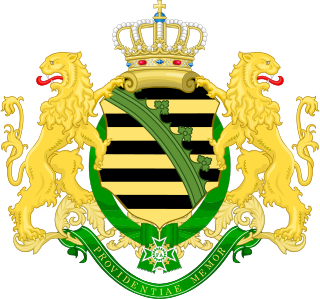
The Royal Saxon Army was the military force of the Electorate (1682–1807) and later the Kingdom of Saxony (1807–1918). A regular Saxon army was first established in 1682 and it continued to exist until the abolition of the German monarchies in 1918. With the formation of the Confederation of the Rhine by Napoleon the Royal Saxon Army joined the French "Grande Armée" along with 37 other German states.
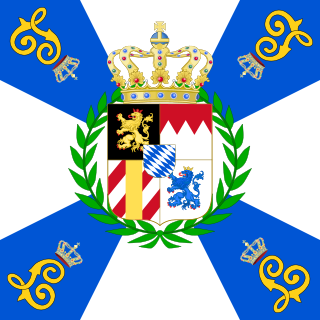
The Bavarian Army was the army of the Electorate (1682–1806) and then Kingdom (1806–1918) of Bavaria. It existed from 1682 as the standing army of Bavaria until the merger of the military sovereignty of Bavaria into that of the German State in 1919. The Bavarian Army was never comparable to the armies of the Great Powers of the 19th century, but it did provide the Wittelsbach dynasty with sufficient scope of action, in the context of effective alliance politics, to transform Bavaria from a territorially-disjointed small state to the second-largest state of the German Empire after Prussia.
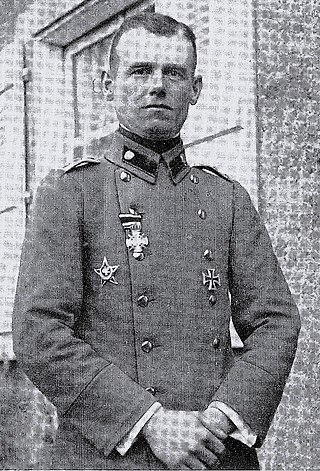
Willy Martin Ernst Rohr was a German Army officer who was a major contributor to the development of infantry tactics in World War I, particularly for the system of Storm Battalions.




















